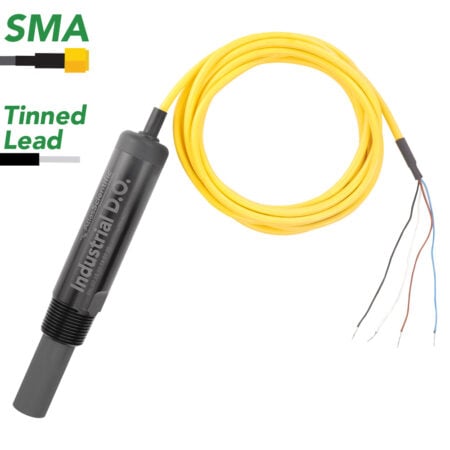Subtotal: $354.99

10 Sensors For Greenhouse Monitoring – A Guide To Precision Agriculture
Greenhouse monitoring is the backbone of precision agriculture, and it starts with the right sensors. The 10 most essential sensors to optimize crop health and
Product Categories

Fish require dissolved oxygen levels between 5-6 ppm (parts per million) to grow and thrive. Low dissolved oxygen levels (>3 ppm) become stressful for most aquatic organisms, and extremely low levels will not support fish survival at all.
Dissolved oxygen is the amount of free, non-compound oxygen molecules in water. Dissolved oxygen is one of the most important parameters when assessing water quality in aquatic systems because of the influence oxygen has on water.
The amount of dissolved oxygen in water is limited by physical conditions like temperature and atmospheric pressure.

In aquaculture, dissolved oxygen (DO) is the most important chemical parameter in determining water quality. Low DO levels are accountable for more fish kills in the aquaculture industry than other factors such as temperature, alkalinity, and salinity.
Just like us humans, fish require oxygen for respiration, therefore the amount of DO in a body of water influences the fish’s chance of survival.
The amount of oxygen that a fish consumes depends on its size, activity level (feeding and reproduction), type of fish, and the temperature of the water. For example, larger fish will usually consume more oxygen than smaller fish. However, smaller fish consume more oxygen per unit of body weight.
Dissolved oxygen is usually measured in milligrams per liter (mg/L) or as a percentage (%) of oxygen saturation. Yet, in most aquaculture industries the amount of DO in water is reported in parts per million (ppm), 1 mg/L is equal to 1 ppm.
When measuring the amount of dissolved oxygen in the water for fish, the unit of measure is parts per million (ppm). Parts per million refers to the number of oxygen molecules per million total molecules in the water.
Fish require dissolved oxygen levels of 5-6 ppm for growth and activity. Low DO levels create a stressful environment for fish, and water with extremely low DO levels (below 2 ppm), cannot support fish.
Some fish, such as freshwater salmon, are particularly sensitive to low ppm levels; for example, freshwater salmon are unable to reproduce when levels drop below 6 ppm, which is usually an ideal environment for most other fish.
Most fish will avoid areas with dissolved oxygen levels lower than 3.7 ppm, and some species of fish will completely abandon areas to find a more suitable environment to live in. When levels continue to decrease below 2 ppm, invertebrates will also leave. Below 1 ppm, benthic organisms like clams, worms, oysters, shrimp-like crustaceans, and mussels that are unable to naturally migrate, will show reduced growth and survival rates.
To understand the full effects that different levels of dissolved oxygen have on fish, we can refer to the below table:
| Dissolved Oxygen (ppm) | Approximate Percentage Saturation at 68℉ (20℃) | Effect On Fish |
| 0-0.3 | 0-4 | Smaller fish can survive short exposure, but larger fish will usually die. |
| 0.3-1.0 | 4-13 | Lethal exposure to DO if prolonged. |
| 1.0-5.0 | 13-64 | Fish may survive, but they will have slow growth to prolonged exposure. |
| 5.0-saturation | 64-100 | The desirable range for fish. |
Aquaculture is one of the fastest-growing animal food-producing industries in the world. According to the FAO, it is estimated that 50% of fish for human consumption comes from the aquaculture industry.
Therefore, maintaining optimal DO levels in fisheries and ponds is essential for fish production; the favorable DO levels for fish culture are between 5 and 20 ppm.
During the summer months, when temperature levels increase, fish farmers may need to aerate the water to maintain adequate levels of dissolved oxygen.
Whether you have a home aquarium or are running a fish farm, some signs indicate that a system has suffered from low DO levels in the water. These include the following:
Oxygen depletion events usually occur after a severe thunderstorm, a prolonged period of hot weather, and when water movement is reduced.
Oxygen depletion is also common in water where they are heavily populated with algae and aquatic plants.
Some fish can physiologically adapt to low ppm levels of dissolved oxygen in water by increasing water flow over their gills. This increases the fish’s oxygen-carrying blood levels, lowering their metabolic oxygen demand.
Adaptations to low DO levels are not an overnight process. It requires long-term exposure to such environments, possibly even sublethal ppm levels. It is also important to note that while some fish can adapt to low dissolved oxygen levels in the water, many cannot and will die if DO levels are not increased.
Dissolved oxygen levels are affected by diffusion, aeration, photosynthesis, respiration, and decomposition. Therefore, temperature, salinity, and pressure changes frequently cause fluctuations in the amount of dissolved oxygen in the water.
The four causes of low DO levels in aquatic habitats are:
A calibrated DO sensor is the most accurate way to measure DO in water. Dissolved oxygen sensors measure the amount of DO directly in the water in mg/L or as a percent dissolved oxygen (%). Remember that 1 mg/L is equal to 1 ppm.

As temperature influences the amount of DO in water, a temperature sensor should be used alongside a DO probe, when determining water quality.
When DO levels are low in aquatic environments, you can:
Dissolved oxygen (DO) is the most important water quality measurement in the aquaculture industry. Fish require DO levels between 5 and 6 parts per million (ppm) to grow and survive.
When DO levels drop below 3 ppm, fish become stressed and will die if DO levels continue to drop below 2 ppm. Therefore, the need to measure DO levels in aquatic systems is essential for the survival of fish and other aquatic organisms.
If you have any questions regarding dissolved oxygen or other water quality measurements and equipment, do not hesitate to contact our world-class team at Atlas Scientific.







Greenhouse monitoring is the backbone of precision agriculture, and it starts with the right sensors. The 10 most essential sensors to optimize crop health and

Hydroponics has revolutionized the way people grow food, offering soil-free methods that deliver nutrients directly to plant roots in water-based systems. But success in hydroponics